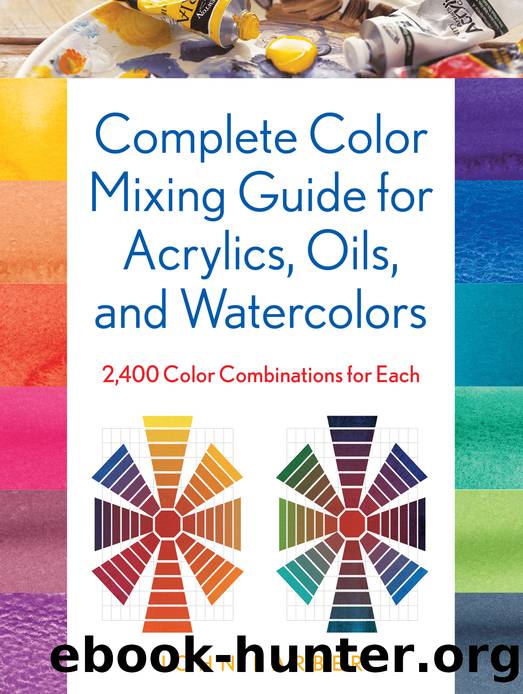Complete Color Mixing Guide for Acrylics, Oils, and Watercolors by John Barber

Author:John Barber
Language: eng
Format: epub
Publisher: Stackpole Books
Published: 2021-12-24T00:00:00+00:00
watercolor mixes
The following pages feature 25 main watercolors that are the most popular with amateur and professional artists. The mixes provide excellent evidence of how few colors a painter actually needs to produce bright, vibrant colors. Use these mixes as guides to help you achieve the exact shade you want, whatever your subject.
papers and brushes
Watercolor painting requires very little equipment: pan or tube paints, sable or synthetic brushes, good paper, and clean water. In watercolor, fine pigments produce clear, bright washes that can be modified by the slightest amount of other colors. This gives the medium great subtlety and flexibility, but if the water in your jar is tinted, then all your colors are being mixed with that tint, however pale it is. It may not be particularly noticeable to you, but it is happening. The ideal solution is to use two large clear jars so that you can see how much the water is colored, using one to wash your brushes and the other to add water to your colors. In practice, most artists use only one jar, particularly when painting outdoors, and change the water frequently.
To ensure the greatest color accuracy, all the color patches in this book were mixed with clean boiled water and a brush washed under the tap when each patch was finished, until the water ran clear.
Storing your brushes upright resting on the handle will keep the bristles in good condition. If treated well, brushes will last for many years.
Download
This site does not store any files on its server. We only index and link to content provided by other sites. Please contact the content providers to delete copyright contents if any and email us, we'll remove relevant links or contents immediately.
Wonder by R.J. Palacio(7768)
Unlabel: Selling You Without Selling Out by Marc Ecko(3012)
POP by Steven Heller(2902)
Hidden Persuasion: 33 psychological influence techniques in advertising by Marc Andrews & Matthijs van Leeuwen & Rick van Baaren(2812)
The Pixar Touch by David A. Price(2761)
Ogilvy on Advertising by David Ogilvy(2721)
Drawing Cutting Edge Anatomy by Christopher Hart(2707)
Slugfest by Reed Tucker(2441)
The Art of War Visualized by Jessica Hagy(2437)
The Curated Closet by Anuschka Rees(2414)
Stacked Decks by The Rotenberg Collection(2303)
365 Days of Wonder by R.J. Palacio(2263)
The Wardrobe Wakeup by Lois Joy Johnson(2252)
The Code Book by Simon Singh(2243)
Rapid Viz: A New Method for the Rapid Visualization of Ideas by Kurt Hanks & Larry Belliston(2229)
Tell Me More by Kelly Corrigan(2213)
Keep Going by Austin Kleon(2183)
Tattoo Art by Doralba Picerno(2101)
Tokyo Geek's Guide: Manga, Anime, Gaming, Cosplay, Toys, Idols & More - The Ultimate Guide to Japan's Otaku Culture by Simone Gianni(1962)
